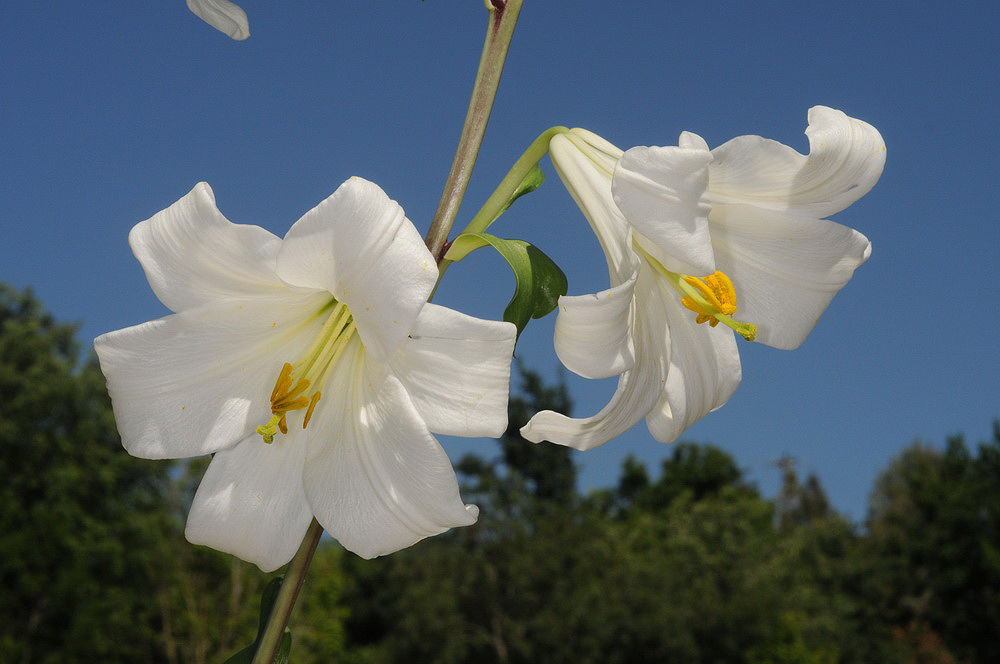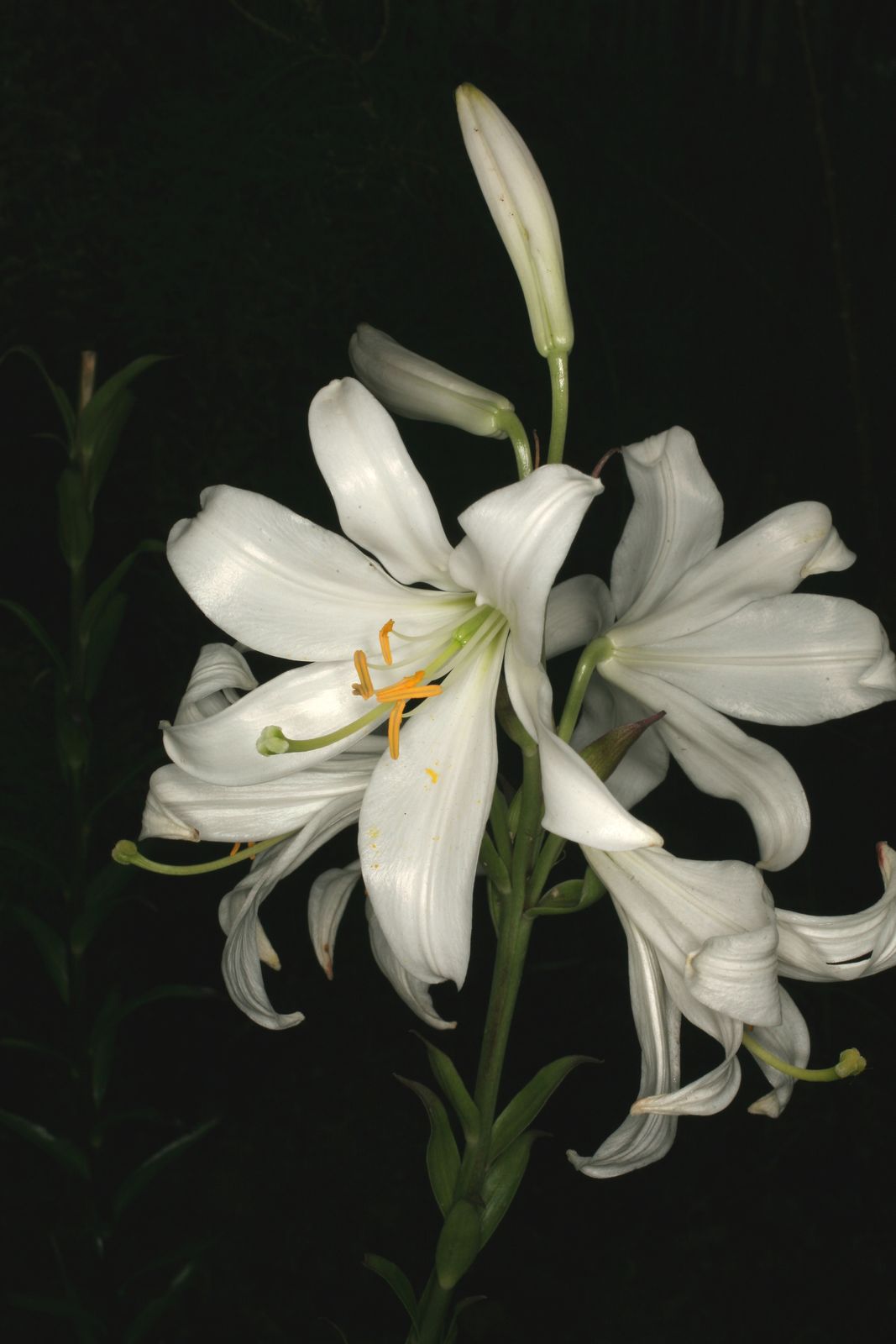Family: Liliaceae
Author: L.
Bibliography: Sp. Pl.: 302 (1753)
Year: 1753
Status: accepted
Rank: species
Genus: Lilium
Vegetable: False
Observations: S. North Macedonia to SW. Türkiye, Lebanon to Israel
Description
The Madonna lily, scientifically known as Lilium candidum, is a striking and historically significant plant belonging to the Liliaceae family. Described by the renowned botanist Carl Linnaeus in 1753 in his seminal work Species Plantarum, this lily has captured the hearts of gardeners and historians alike for centuries.
Native to regions stretching from southern North Macedonia to southwestern Türkiye, and extending from Lebanon to Israel, the Madonna lily thrives in a range of climates within these areas. This lily is distinct for its elegant, pure white petals and a golden, pollen-rich center that exudes a delightful fragrance. The flowers, which typically bloom in late spring to early summer, display a classic trumpet shape, lending an air of timeless beauty and refinement to any garden or natural landscape.
Historically, the Madonna lily holds immense cultural and religious significance. Often associated with purity and virtue, it has been a symbol in Christian iconography, frequently depicted in artworks featuring the Virgin Mary, hence its common name. Beyond its religious connotations, the plant has also been used in traditional medicine and cosmetics, prized for its soothing and skin-healing properties.
Growing the Madonna lily requires well-drained soil and a sunny location, though it can tolerate some shade. The plant prefers a temperate climate and benefits from a period of cold dormancy in the winter to encourage robust flowering in the warmer months. Care should be taken to protect the plant from extreme weather conditions, as it can be susceptible to frost damage.
In summary, Lilium candidum or the Madonna lily, with its pristine blossoms and rich historical roots, remains a beloved addition to both cultivated gardens and wild landscapes across its native range. Whether appreciated for its beauty, fragrance, or symbolic meanings, this lily continues to enchant and enthrall all who encounter it.
Common Names
Fra: lis blanc
Eng: madonna lily, white lily
Dan: madonna-lilje
Deu: weiße lilie, madonnen-lilie
Por: açucena, cajado-de-são-josé
Swe: madonnalilja
Nld: witte lelie
Nno: madonnalilje
Nob: madonnalilje
En: Madonna lily, White lily, White lilly
Ar: زنبق أبيض
Az: Ağ zanbaq
Eu: Zitori arrunt
Bg: Белоснежна лилия
Ca: Lliri blanc
Zh: 圣母百合, 聖母百合
Cs: Lilie bělostná
Da: Madonnalilije, Madonna-lilje
Nl: Witte lelie
Et: Madonnaliilia
Fi: Madonnanlilja
Fr: Lis blanc, Lys, Lys à fleurs blanches
De: Madonnen-Lilie, Weiße Lilie, Madonnen-Lilie, Weiße Lilie
He: שושן צחור
Hu: Fehér liliom
It: Giglio di Sant’Antonio
Ku: Zembeq
Lt: Baltoji lelija
Nb: Madonnalilje
Nn: Madonnalilje
Fa: لیلیوم کاندیدوم
Pl: Lilja, Lilia biała
Pt: Açucena, Cajado-de-são-josé
Pt-br: Açucena-branca, Lírio-branco
Ro: Crin alb
Ru: Lilija belaja, Лилия белоснежная
Sc: Lizu
Sk: Ľalia biela
Es: Azucena
Sv: Madonnalilja, Madonnalilija
Zh-tw: 聖母百合
Zh-hant: 聖母百合
Tr: Ak zambak
Uk: Лілія біла
Synonyms
- Lilium candidum f. peregrinum ((Mill.) Voss)
- Lilium candidum var. striatum (Baker)
- Lilium candidum var. purpureostriatum (Souillet)
- Lilium candidum var. cernuum (Weston)
- Lilium album (Houtt.)
- Lilium striatum (Baker)
- Lilium candidum var. rubrolineatum (E.Vilm.)
- Lilium candidum subsp. peregrinum ((Mill.) Baker)
- Lilium candidum var. purpureum (Weston)
- Lilium candidum var. plenum (Weston)
- Lilium candidum f. striatum ((Baker) Voss)
- Lilium candidum var. salonikae (Stoker)
- Lilium candidum var. peregrinum ((Mill.) Pers.)
- Lilium candidum var. variegatum (G.Don)
- Lilium peregrinum (Mill.)
- Lilium candidum var. monstruosum (E.Vilm.)
- Lilium candidum var. aureomarginatum (Elwes)
Distribution
- East Aegean Is. (native)
- Greece (native)
- Lebanon-Syria (native)
- Palestine (native)
- Turkey (native)
- Yugoslavia (native)
- Albania (introduced)
- Algeria (introduced)
- Bulgaria (introduced)
- Canary Is. (introduced)
- Corse (introduced)
- Czechoslovakia (introduced)
- East European Russia (introduced)
- France (introduced)
- Italy (introduced)
- Madeira (introduced)
- Mexico Central (introduced)
- Mexico Southwest (introduced)
- Pennsylvania (introduced)
- Portugal (introduced)
- Sardegna (introduced)
- Sicilia (introduced)
- Spain (introduced)
- Transcaucasus (introduced)
- Tunisia (introduced)
- Ukraine (introduced)
Additional Images
Flower
Taken Jun 11, 2017 by Fejul Xeto (cc-by-sa)
Taken Sep 6, 2017 by Dieter Wagner (cc-by-sa)
Taken Feb 22, 2019 by Catherine Johan (cc-by-sa)
Taken Dec 14, 2017 by Dieter Wagner (cc-by-sa)
Taken Dec 5, 2017 by Gustavo Coraglia (cc-by-sa)
Fruit
Taken Jan 9, 2018 by Beverly Patrick (cc-by-sa)
Leaf
Taken Jul 11, 2020 by delphine perret (cc-by-sa)
Taken Jul 11, 2022 by Soňa Keprtová (cc-by-sa)
Taken Nov 6, 2021 by David Hocken (cc-by-sa)
Taken Sep 20, 2019 by Dieter Wagner (cc-by-sa)
Taken Nov 29, 2019 by Henrique Mourato (cc-by-sa)

© copyright of the Board of Trustees of the Royal Botanic Gardens, Kew.

© copyright of the Board of Trustees of the Royal Botanic Gardens, Kew.

© copyright of the Board of Trustees of the Royal Botanic Gardens, Kew.
Other
Taken Jun 22, 2020 by Rossu . (cc-by-sa)
Taken Mar 1, 2022 by Annemarie Ahrens-Stehle (cc-by-sa)
Taken Oct 16, 2022 by Jim Knopf (cc-by-sa)
Taken Apr 5, 2022 by Jim Knopf (cc-by-sa)
Taken Apr 5, 2022 by Jim Knopf (cc-by-sa)
Habit
Taken May 30, 2020 by Aaron Harp (cc-by-sa)
Taken Jul 27, 2021 by Mercymary Frank (cc-by-sa)
Taken May 9, 2020 by Stefano Franchitti (cc-by-sa)
Taken Mar 20, 2021 by Fresquita Palangana (cc-by-sa)
Taken Dec 24, 2019 by Pierre Michels (cc-by-sa)
Bark
Taken May 9, 2020 by Stefano Franchitti (cc-by-sa)
Taken Jul 9, 2019 by Satan Satan (cc-by-sa)
Taken Jun 18, 2021 by Sabin Poenariu (cc-by-sa)
Taken Jun 24, 2021 by Dirk Lohse (cc-by-sa)
Taken Jun 7, 2021 by Tiffany Miller (cc-by-sa)
Sources
- WFO (No URL)
- IPNI (No URL)
- GBIF (https://www.gbif.org/species/2753090)
- POWO (http://powo.science.kew.org/taxon/urn:lsid:ipni.org:names:537512-1)
- PlantNet (https://identify.plantnet.org/species/the-plant-list/Lilium candidum L.)
Specifications
Growth habit>: Forb/herb
Growth
Ph maximum: 8.0
Ph minimum: 7.5
Light: 7
Atmospheric humidity: 4
Bloom months: [‘may’, ‘jun’, ‘jul’]
Soil nutriments: 6


























